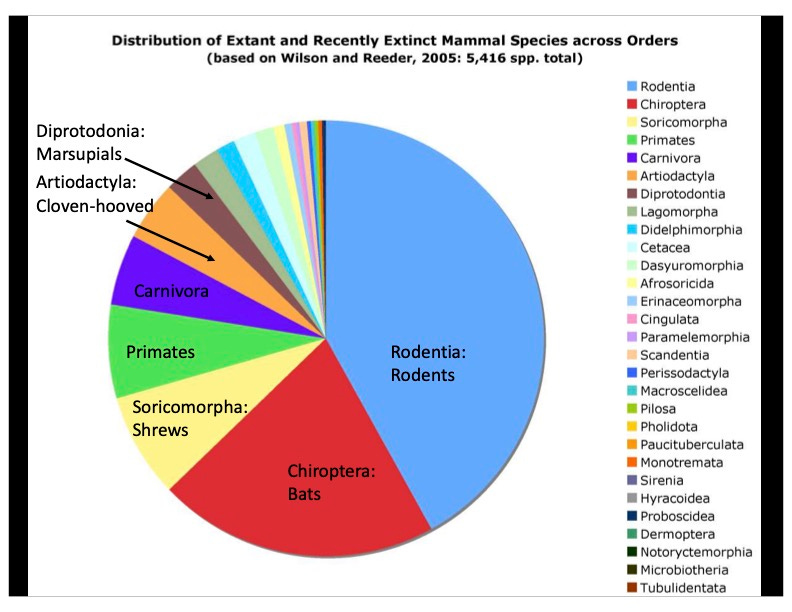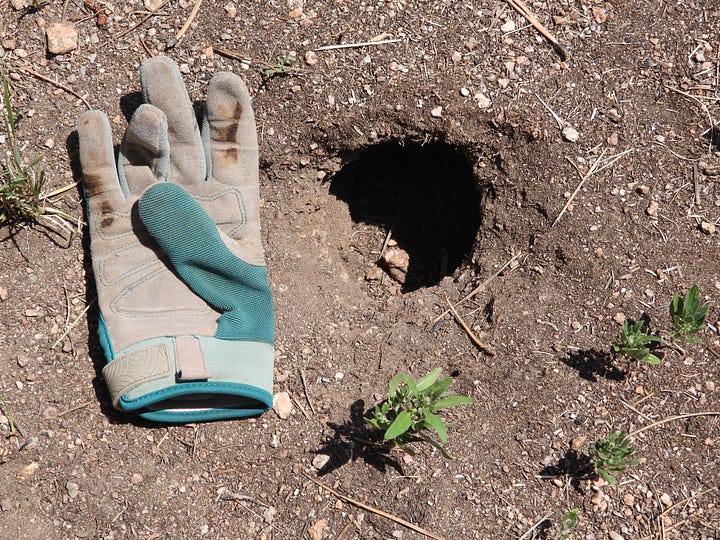
Personal note: Summer is an over-abundant time colliding with all that is happening in the natural world - so much blooming and new life happening! - and the realities of our schedules. This is the time of events and projects, gatherings and high-season with my work. Unfortunately, the calendar dictates where my time goes. Not enough of our summer days allow for the freedom of time to observe, research, and write. My mind has wanted to log all the natural life I am observing, my schedule says to head out to the next thing. Our major summer events are largely behind us now, and I hope to focus more on writing - hope to. Life often has other plans. We have had the joy of watching a brood of Mallard ducklings go from tiny newborns to fledging this past week. I’ll write more on that soon. Onto squirrels again.
The first look out the sliding glass door each morning often has something interesting. Usually, it’s the birds, a heron, or hummingbird battles, sometimes it’s the coyotes out for a morning hunt, this morning, it was a fox. Silhouetted in the rising sunlight, its color and details hidden, but with the shorter stature than the coyotes, the glorious tail and the tall ears above the grasses gave him away. As he trotted through the wetlands, I followed those ears above the grasses and Cinquefoil shrubs, - no time to grab my camera, of course - then he stopped, listened, and leapt in that classic fox pounce. Success! I watched him chomp and swallow down a bit of breakfast, nose high in the air to let gravity help it go down. It doesn’t take much speculation to guess what Mr. Fox caught. I’m sure it had 4 little paws, black stripes, little round ears, and a short fuzzy tail, certainly, some variety of rodent.
I’ve written a lot about the tree squirrels here in the Foothills, but that’s only half the squirrelly story. There are the ground squirrels too. While Colorado has quite a variety of ground squirrels, our prominent critter is the regally named Golden-Mantled Ground Squirrel. Individually, they are adorable, chubby, and proportioned just right from ears to tail. Down their backs run 2 white-ish to tan stripes bordered by black stripes. The ‘mantle’ across their shoulders is a golden to reddish tinge, with the males having a more pronounced red to it. They are uniquely a Western North American critter that prefer the cooler, mountain elevations and rocky terrain. In fact, recent studies are showing that climate change is causing them to migrate to even higher terrain as summer temps are getting hotter, their territory has climbed up 1100 ft higher in elevation since 1980s.


Unlike our tree squirrels who make their homes in the trees and do not hibernate, the ground squirrels have created grand cities underground, filled with seed storage, living rooms, hibernaculums (for sleep and hibernation), water drainage tubes, and even a latrine area. There are front-doors, back-doors, and side-doors, often extending a squirrel’s burrow to up to 100 feet long. Depths vary from near the surface to a full meter down. Here’s where their adorableness ends with many property owners. A ground squirrel’s construction is certainly destruction to us, as the land becomes pocked with countless holes, many large enough to drop a golf ball or even a baseball down. Research on ground squirrels brings up countless sites and companies all about managing or exterminating the pests. I’ll get to some of what works and what doesn’t in a bit, but first, to get some perspective on why they do belong here.
The Golden-Mantled Ground squirrels (GMG for short) are a part of a category that makes up 40% of all mammals on earth: the rodents. Yes, you read that right, 40%!

Rodents are what are categorized as ‘primary consumers’ (no, that’s not rodent capitalism), so let’s jump back to Junior-High Biology class and remember some basics of the food web. Naturalists like to refer to these ‘primary consumers’ as a conduit of ‘sunshine to protein’. So, here’s the order if you’ve forgotten those early biology courses:
Sunshine is critical to all life on earth,
Plants can make their own food by photosynthesizing sunshine into sugars, and from this, they grow new leaves, stems, flowers, fruits and seeds. They are the Primary Producers.
Primary Consumers - the rodents, in our case - eat the plants, and they live and grow, and reproduce, and reproduce. (Yes, I know many other animals, including us, eat plants, but we need to condense this down for now.)
As small, mainly plant eating creatures, they multiply quickly and have populations that far exceed the next animals up the food chain.
Here come the predators, many of whom are only meat eaters, and they are much larger than the rodents. Mr. Fox will eat up to 8 rodents in a day. The owls, hawks, coyotes, wolves, ermine, pine martens, and snakes will also take their share. The rodents become protein for the predators. These predators keep the rodent populations in balance as well.
So, there you have it, conduits of sunshine.

GMG and other ground squirrel tunnels are also used by boreal toads, snakes, and other ground dwelling creatures. They consume a wide variety of seeds, fungi, and grasses. Seeds are stored and redistributed throughout the forest. Amazingly, GMGs were one of the first mammals to recolonize the blast zone area of Mount St. Helens. This makes them a ‘pioneer species’. Their spreading of this wide variety of seeds helped to reseed, and thereby, regrow the area. The little guys play big roles. It is thought that they are a part of the consumption of Ponderosa Pine seeds, and help to create the open, park-like, feel of Ponderosa Pine forests, not letting seedlings grow too close to each other. I reccomend listening to the interview with Sciuridologist (that’s a squirrel expert!), Dr. Karen Munroe, who was on the ‘Ologies’ podcast a year ago, in which she discusses the squirrel’s role, in the planting of all of our forests. Without squirrels, we wouldn’t have forests. That’s a big deal.
When seen as merely pests, the main human problem-solving tactic moves quickly to ‘just kill them off’. Certainly poison does the trick, but the repercussions of poisons are a heavy toll. If a predator such as a hawk, owl, fox, or coyote eats a poisoned squirrel, or many such squirrels, (the poison portion is then multiplied), that creature is likely killed as well. If the poisoned squirrel is fed to nestlings, the brood can be wiped out. Poison doesn’t tend to stay at its initial purpose. If you are spraying grasses or weeds, you magnify the effect one step further back as all the primary consumers eat the poisoned plants, and the effect works on up the food chain.




Filling in the holes or flooding them hardly affects the squirrels at all, they just expand the burrow. That said, I’m not fond of all the new holes in my yard as there has been a lot of squirrels this summer, but I put up with them since they’ll just dig a new hole and make the problem worse. What I will do, though, is I refuse to share my greenhouse veggies with them. Deterrent pepper spray from the hardware store has been effective, as have shavings of Irish Spring soap around the interior wall of the greenhouse. These are deterrents and not poisons. I’ve also seen many comments on the effectiveness of dryer sheets. Bear in mind, these are for small areas that you want them to stay away from, like gardens, and greenhouses, and not for broad areas. (The pepper spray stopped the Pine squirrel from filling our RV engine with pine cones again!) Putting any deterrent in their holes, just sends them make another hole. GMGs have been around for the past 12,000 years, making them a very successful species. They likely have further ecological effects that we have yet to understand also.
So, make friends with them, but don’t be too chummy. Feeding them is a foolish tourist stunt that makes them dependent on our nutritionally-void cheese puffs and other bits. It’s not cute to let them take food from your hand either, as they can carry diseases such as bubonic plague, or the fleas that carry disease, so hands off, cuz ya never know. Appreciate when you see Mr. Fox having breakfast, or Mrs. Redtail hawk flying off with one. They are only around for another month or so, and will be hibernating by September. Then, you can go fill in those unsightly holes in your yard, ready for next summer’s batch.
Thank you for stopping by. While my normal life is full with my paying job, other volunteer work, and family time, I write these posts out of my own naturalist curiosity, and love of writing and photography. Many times, this blog has to take a back seat to my other obligations, but I always have the next post on my mind. My subject matter is limitless! If you have enjoyed these posts, I would, shyly, ask for your support of my work here. Please consider subscribing or upgrading to a paid subscription, and do share what you have enjoyed. I am looking at some benies for paid subscribers of artwork from Itsthemoonart©️, whose artwork has appeared in other posts and my logo (my naturalist-artist daughter and content advisor) and other ideas. I am very thankful for all my subscribers and supporters! Oh! And please let me know if you have ideas you’d like to see a post about!
📷 All photos are credit: The Abert Essays unless otherwise noted.
📱 Join me on my Facebook page and other social media. I post smaller ‘Encounters’ posts there as I see flowers, animals, weather patterns, and anything else that catches my eye.
Sources:
- https://www.fs.usda.gov/rm/pubs_journals/2006/rmrs_2006_shick_k001.pdf
- https://animaldiversity.org/accounts/Spermophilus_saturatus/
- https://academic.oup.com/jmammal/article/92/2/367/865749
- http://npshistory.com/publications/crla/feeding-ground-squirrels.pdf
- https://richardsonsgroundsquirrel.wordpress.com/burrow-systems-hibernacula/
- https://www2.nau.edu/lrm22/lessons/food_chain/food_chain.html
- https://www.sciencedirect.com/science/article/abs/pii/S0065266008604046
- https://en.wikipedia.org/wiki/Rodent
- https://en.wikipedia.org/wiki/Golden-mantled_ground_squirrel







